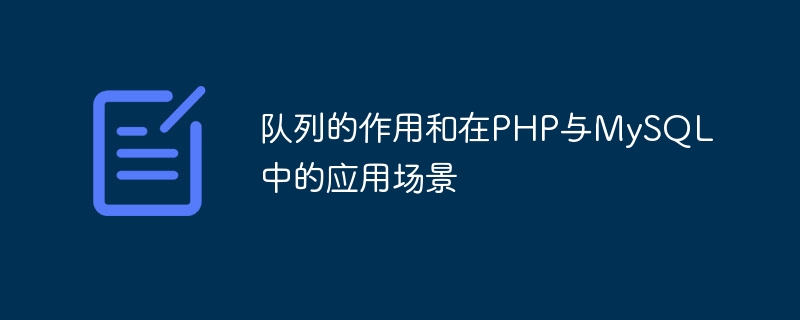

The role of queues and application scenarios in PHP and MySQL
Queue is a very important data structure in computer science, it can help us achieve the task Asynchronous processing and decoupling. The basic principle of the queue is "first in, first out", that is, the tasks put into the queue first will be taken out for processing first.
The role of queue:
The following are some application scenarios and specific code examples for using queues in PHP and MySQL.
PHP code example:
<?php
// 异步发送邮件任务的函数
function sendMail($to, $subject, $content) {
// 发送邮件的相关逻辑...
echo "Sending email to: {$to} - Subject: {$subject} - Content: {$content}
";
sleep(1); // 模拟邮件发送的耗时
}
// 将邮件发送任务放入队列
function queueMail($to, $subject, $content) {
$data = [
'to' => $to,
'subject' => $subject,
'content' => $content
];
$queue = new RedisQueue(); // 假设使用Redis作为队列存储
$queue->push(json_encode($data));
}
// 从队列中取出邮件发送任务并执行
function processMailQueue() {
$queue = new RedisQueue(); // 假设使用Redis作为队列存储
while ($data = $queue->pop()) {
$task = json_decode($data, true);
sendMail($task['to'], $task['subject'], $task['content']);
}
}
// 示例代码
queueMail('example@example.com', 'Hello', 'This is a test email');
processMailQueue();
?>PHP code examples:
<?php
// 批量插入数据到MySQL
function bulkInsert($data) {
$values = [];
foreach ($data as $row) {
$values[] = "('{$row['name']}', '{$row['age']}', '{$row['gender']}')";
}
$sql = "INSERT INTO users (name, age, gender) VALUES " . implode(',', $values);
$db = new PDO('mysql:host=localhost;dbname=test', 'username', 'password');
$db->exec($sql);
}
// 将数据放入队列
function queueData($data) {
$queue = new RedisQueue(); // 假设使用Redis作为队列存储
foreach ($data as $row) {
$queue->push(json_encode($row));
}
}
// 从队列中取出数据并批量插入到MySQL
function processQueue() {
$queue = new RedisQueue(); // 假设使用Redis作为队列存储
$bulkSize = 100; // 每次批量插入的数据量
$data = [];
while ($row = $queue->pop()) {
$data[] = json_decode($row, true);
if (count($data) >= $bulkSize) {
bulkInsert($data);
$data = [];
}
}
if (!empty($data)) {
bulkInsert($data);
}
}
// 示例代码
$data = [
['name' => 'Alice', 'age' => 25, 'gender' => 'female'],
['name' => 'Bob', 'age' => 30, 'gender' => 'male'],
['name' => 'Charlie', 'age' => 35, 'gender' => 'male'],
// 更多数据...
];
queueData($data);
processQueue();
?>The above are some application scenarios of queues in PHP and MySQL and specific code examples. By rationally using queues, the performance and maintainability of the program can be improved and more powerful functions can be achieved.
The above is the detailed content of The role of queues and application scenarios in PHP and MySQL. For more information, please follow other related articles on the PHP Chinese website!